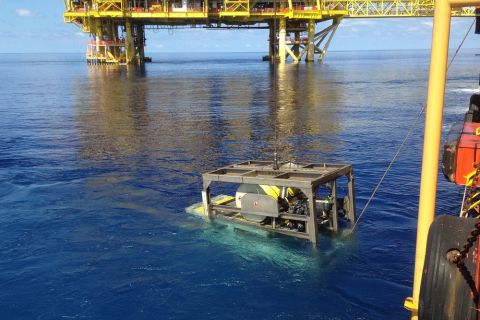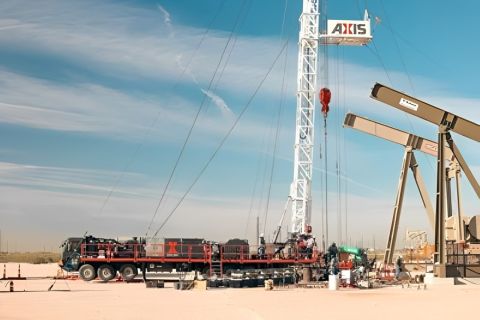The life cycle of water in the oil field is primarily viewed as a logistical problem concerning the movement of water from a source to the field and from the field to treatment or disposal. One of the most overlooked factors is storage.
Storage issues are associated with the process at nearly every step and affect the economics of water reuse. Although great strides are continually being made in oilfield water-treatment technologies, water storage is one of the biggest impediments to universal oilfield water reuse.
Tanks and in-ground pits have historically been used for field water storage and continue to be used in many operations. The high-capacity above-ground storage tank (AST) is a recent innovation that has quickly become an industry standard in large-volume temporary storage because it allows operators to save money on their produced water recycling operations.
With capacities ranging up to more than 40,000 bbl, ASTs supplied by Rockwater Energy Solutions can replace more than 80 standard tanks used in hydraulic fracturing operations—tanks that, on average, can handle 500 bbl each. ASTs are available in multiple sizes ranging from 4,500 bbl to 41,000 bbl. These steel ASTs can be more than 3 m (10 ft) tall and are typically lined with a system of recyclable polyethylene liners and geo-textile underlayments to prevent leaks. Structural integrity of the tanks is usually checked through regular nondestructive tests like magnetic particle inspection and ultrasonic testing.
Environmental responsibility
Operators seeking to advance sustainability goals have turned to ASTs to reduce truck trips and their associated emissions, dust and road damage when compared with conventional tanks. A 40,000-bbl AST can require four to 12 tractor-trailers to hold the ancillary equipment required for setup vs. the 80 tanks requiring 80 tractor-trailers. That can amount to a reduction of more than 150 truck trips.
The physical footprint of ASTs compared to average tanks provides an additional environmental benefit as it relates to ground disturbance and logistics on location. For example, a 40,000-bbl AST covers approximately 1,858 sq m (20,000 sq ft), whereas the same volume would require 80 tanks covering about 3,344 sq m (36,000 sq ft). Not only does an AST take up less space, but it also reduces clutter on location by eliminating manifolds and hoses, helping to prevent slips, trips and falls.
Economics of water storage
ASTs were designed to maximize per-well capital efficiencies—a concept that is now field-proven as horizontal wells completed on multiwell pads become more widespread. AST costs—including daily rental, set up and tear down—are usually lower than tanks for large fluid volumes and multistage wells.
Beyond the set-up costs, water transfer is where the most significant cost savings are realized. ASTs improve the efficiency of water transfer operations, reducing the number of failure points by using fewer connections and valves. A breakdown of the cost per barrel reveals lower set-up and tear-down water transfer costs, daily rentals, and labor charges, which in turn translates into significant savings on overall water management.
Optimal storage for water treatment
Water treatment programs stand to gain the most by incorporating ASTs for incoming water and treated water storage. Water stored in 80 tanks instead of one 40,000-bbl AST is more challenging to maintain operationally and to assure the consistent quality of treated water. This is important to any field water-treatment system because water in an AST can be homogenized before and after treatment.
The process of collecting and analyzing samples from 80 tanks requires significantly more time than evaluating four or five samples from a continuous content storage unit, whether a pit or an AST. A consistent water base before treatment means fewer variation requirements in the treatment process, which reduces labor and materials and also ensures more consistent water afterward.
A homogenized treated-water base for hydraulic fracturing allows the pressure-pumping company to maintain operations without having to change chemistries due to base-water variation, which can be the key to a successful completion. Although a more consistent treated-water quality can be achieved by improving the consistency of the incoming raw water from an AST, treated water can and does vary.
Changes in treated water alkalinity, pH, dissolved iron, oxidation reduction potential, free available chlorine, dissolved oxygen, bacteria numbers and biocide residuals may change as the time between treatment and use is lengthened. Changes in just one of these attributes may have a profound impact on guar hydration or crosslinked fluid stability.
Regulations on fluid storage vary widely by state depending on the fluid type. Progress is being made in North Dakota, Pennsylvania, Colorado, Wyoming, and other states toward the use of ASTs for produced-water storage. A nested tank in a system recently piloted by Rockwater demonstrated how a liner failure could be isolated, thereby reducing the risk of catastrophic tank failure. This innovation should improve the economics for water reuse and potentially change the landscape of oilfield water storage.
Smaller footprint, lower cost
Determining the true cost of storage requires looking outside the tank. It is simple math that above-ground storage can have a tremendous environmental impact by reducing the number of truckloads. However, the cost of conventional storage is often overlooked in terms of supporting services such as water transfer and water treatment programs.
When water management is approached holistically and all processes and services are considered in the construction of a well instead of looking at compartmentalized services, the result can be an optimized solution with a reduced environmental footprint at a lower cost to the operator.
Recommended Reading
Forum Energy Signs MOU to Develop Electric ROV Thrusters
2024-03-13 - The electric thrusters for ROV systems will undergo extensive tests by Forum Energy Technologies and SAFEEN Survey & Subsea Services.
Axis Energy Deploys Fully Electric Well Service Rig
2024-03-13 - Axis Energy Services’ EPIC RIG has the ability to run on grid power for reduced emissions and increased fuel flexibility.
TotalEnergies Rolling Out Copilot for Microsoft 365
2024-02-27 - TotalEnergies’ rollout is part of the company’s digital transformation and is intended to help employees solve problems more efficiently.
PGS Wins 3D Contract Offshore South Atlantic Margin
2024-04-08 - PGS said a Ramform Titan-class vessel is scheduled to commence mobilization in June.
TGS Commences Multiclient 3D Seismic Project Offshore Malaysia
2024-04-03 - TGS said the Ramform Sovereign survey vessel was dispatched to the Penyu Basin in March.





